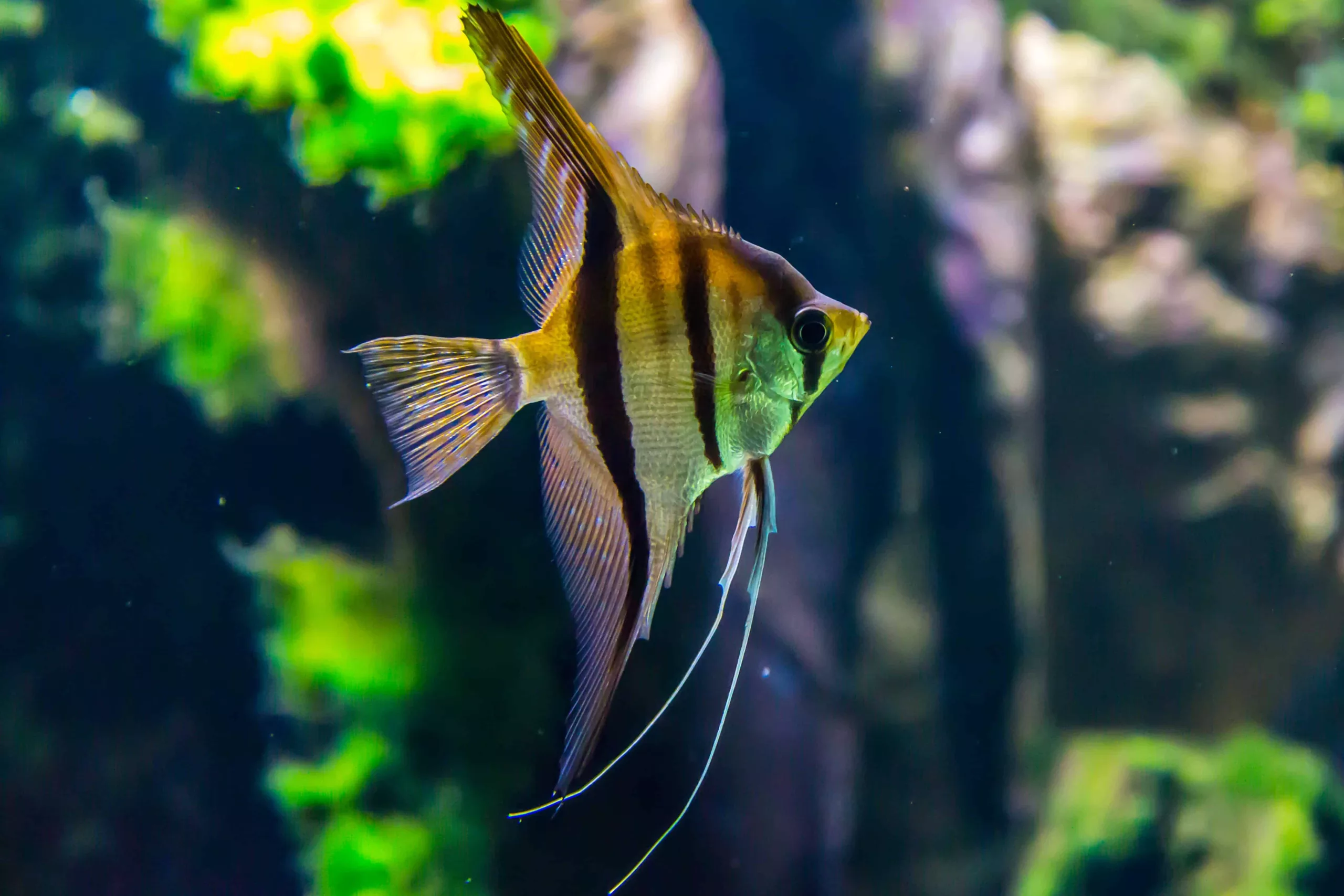Jump Ahead To:
You’re getting ready to move to your new home. It’s easy to figure out the best way to move your stuff. But how are you going to move your fish tank and its inhabitants? Feels like it took forever to get your tank set up and establish a happy place for your fish and other underwater critters. The idea of taking it all down and starting from scratch is intimidating. And will your fish and other living members of your tank survive the trip? Read on for the answers and some helpful tips.
Moving with fish
We’re going to be perfectly honest here. Moving your fish isn’t going to be easy on you or the fish. Of course, a small tank of freshwater, low-need fish will obviously be a lot easier to relocate than a huge saltwater tank with animals that need very stable conditions to thrive. But it’s difficult to maintain the right level of oxygen and temperature when your fish are in containers as opposed to their comfy tank. Depending on how emotionally invested you are in your fish, and how far away you’re moving (the risks rise fast when your fish are in transit for more than a few hours), it’s likely to be much kinder to find someone local to adopt your fish.
Usually, a fish tank and its various accessories can go into the moving truck, but the fish and other living creatures (like corals) need to travel in a more controlled environment. In fact, movers typically aren’t allowed to transport pets.
So your fish may be traveling with you. Consider the logistics. If you are moving during the middle of summer or winter, you may have a really hard time keeping your fish comfortable during the trip. If you’ll need to drive for more than a day, consider boarding your fish at an aquarium supply store that is able to ship your fish to your new home after you arrive and get the tank set up. And if you’ve opted to move your fish on your own, we suggest that you still check with an expert for specific guidance on how to best move your fish. Different species have different needs, and we can’t cover them all in this article.

Get your fish ready to go
You’ll want to stop feeding your fish 24-48 hours before moving day, so their current tank and new temporary containers will stay as clean as possible. Typically fish will be fine without food for about a week, if you have any doubts about this check with an expert.
Figure that moving your fish from their tank should be the last moving chore you do – you want to limit their time out of their tank as much as possible. And your tank should be the first thing you set up when you get to your new home.
If your fish are small and hardy, and your new home is about an hour away, you can transport them in plastic bags – probably the same set up as you used to bring them home from the pet store where you initially got them. You’ll want to fill the bag with water from their tank, leaving plenty of space for air on top. Place the bag/s in a study container – a cooler can work well.
If your fish are bigger than 6 inches or so, or you’re moving small fish further than an hour away, you’ll want to put them in large buckets or containers such as a sturdy cooler. Containers need to be sparkling clean – and don’t use anything that previously contained chemicals or other potentially toxic contents.
Any of our Bellhop professional movers will tell you that you never, ever want to lift or transport an aquarium that has any water or gravel in it, even if it’s a small tank. The weight of the gravel and water, and the movement of water sloshing around is likely to damage the tank.
Plus, as noted above, your fish will obviously need water to travel in, and will much prefer the water from their tank.
Moving fish safely
Make sure you have what you need – a fish net, siphon hose, buckets or transport containers, and containers for your coral and live plants as well. You may need aeration and temperature control devices – like air rocks or battery-powered heating devices – to ensure your fish have what they need to survive. If you do adjust the temperature in containers, be very careful not to overheat the fish. It’s easy to do in a small container.
Start by removing any decorative items from your tank, cleaning them off, and packing them away.
Then fill the containers that you will use to transport the fish with water from the tank, using a siphon hose. Don’t fill containers to the top. Use the biggest containers that are practical.
When your containers are ready, slowly and calmly start removing your fish from the tank. Place them into the prepared containers. Don’t overcrowd them, and make sure any fish with attitudes are isolated from their more mellow tankmates. Fish in a small container can’t easily evade or hide from others, as they can in a properly set-up tank.
Remove any coral, live plants, live rock and other creatures. Place them in containers that are filled with water from the tank. Then transfer any remaining aquarium water into plastic buckets, using the existing water will help your fish acclimate to their new home.
Time to get moving! Position your fish in a safe, stable place in your vehicle – the back floor is likely best. Keep them out of the sun, and away from heat/AC vents. Try to limit sudden stops and starts, and keep the radio volume down, especially if you have a powerful sound system in your car. Vibrations can really stress out your fish.
Check your fish periodically – but not every five minutes! You’ll freak them out if you disturb them too often – to make sure they aren’t in distress. If they are gasping or hanging at the surface they need more air. Consider bringing a battery operated air pump along to aerate containers as needed, or add air rocks to the containers. And if you need to stop overnight, bring your fish with you.
Packing and moving an aquarium
Let your movers know you need a fish tank moved (along with any other fragile, sizable or other items that need special care). Depending on your location, your Bellhop movers may be able to wrap the tank for you. Check to see if packing services are offered when you are booking your move.
If you’d prefer to pack the tank on your own, use plenty of bubble wrap to protect it. Clear the tank of any random accessories unless they are very lightweight. The filter should be kept damp and packed in a sealed container. You can use moving blankets for additional protection if you can’t find a study box big enough for the tank. Ask your movers for tips on how best to pack the tank and other fragile items like covers and lights.
Professional movers know how to secure tanks and other fragile items in moving trucks to reduce the risk of damage. But if you have a huge (over 300 pound) tank, you should seriously consider the benefits of selling it locally and purchasing a new one later. Remember that it’s best to have the tank set up right away, and move the fish into their new home as soon as possible. Maybe you can get the new tank ready to be filled prior to actually moving in, or have a friend or aquarium service help you.
Setting up your fish tank after a move
Say a fast hello to your new home, and start setting up the tank ASAP. The process is different depending on what type of fish and animals live in your tank, so the following is just general advice – please ask an expert for specific guidance on how to re-establish your tank.
- Get your tank situated and stabilized.
- Add the non-living components – sand, gravel, rocks, décor, etc.
- Transfer tank water and top off with de-chlorinated water, if needed. (Use the right mix/treatments for saltwater tanks).
- Get your filter, circulation pump and heater set up. Wait at least an hour before turning on the tank heater.
- Add the cover and lights, plug them in, and regularly check the temperature, PH balance, chlorine level, and ammonia level to make sure everything is back to normal before you move your fish and other living items back to the tank.
- Don’t feed your fish for 24 hours, and then resume with a light feeding. They may refuse to eat for a day or two, this is normal.
New Tank Syndrome
No matter how carefully you moved your tank, the biological balance has probably been disrupted. Check the temperature at least once daily for a week or so, and adjust the heater if necessary. Test for ammonia and nitrite levels 3 to 5 days after you’ve reestablished the tank, and correct if levels are elevated. If the water gets cloudy, continue feeding lightly and add additional carbon to the filter until the water clears up.
Keep an eye on your fish for any signs of disease, and take the appropriate actions – isolation, medicine, tank water treatments, as needed. Sadly, some of your fish may not make it, so be prepared for that. Fish just don’t like moving.
If you moved a saltwater tank, reestablishing it will be harder, as you probably have guessed. Now is a good time to make friends with the folks at a nearby, well-stocked and professional aquarium store.
Making moving easier
Moving fish is hard, so choose movers who will make everything else easier for you. Bellhop has spent a lot of time figuring out how to make moving as easy and pleasant as humanly possible – from your first contact with our company to the final handshake, whether you’re moving cross-country or across town (and anything in between). Find the best movers near you, today.
Other Long-Distance Moving Guides
Long-distance moves are undeniably tricky. We’ve put together a few guides to help you manage some of the thornier points of a long-distance move. And of course, if you need help with your long-distance move, just give us a call.
- Tips to prepare for a long-distance move
- Moving long-distance with a piano
- Cheapest way to move furniture long-distance
- Moving long-distance with kids
- Moving a refrigerator long-distance
- Moving long-distance with a dog
- How to pack pots & pans for a long-distance move
- How to pack dishes for a long-distance move
- How to move long-distance with a cat
- How Much Do Movers Cost? Moving Company Costs Explained. (Updated 2024) - July 9, 2024
- How to Pack for a Move in Three Days (Or Less!) - July 9, 2024
- How to Pack for a Move (Without Going Crazy) - June 26, 2024




